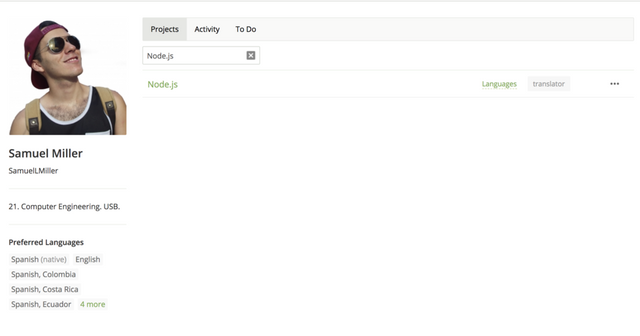[Translation][Spanish] Node.js (1143 words) (Part 42)

Repository
https://github.com/nodejs/i18n
Project Details
Node.js, by definition, is an open-source, cross-platform JavaScript run-time environment that executes JavaScript code outside the browser. This means that now it is possible to execute a program written in JS outside a web browser such as Google Chrome, Safari, etc. This creates an extension to what the language can do, besides just creating interactive websites. With the help of the V8 JavaScript runtime engine, it can now take the code and convert it into a faster machine code, e. g., Node.js eliminates the waiting and continues to take care of the next task.
From my personal perspective, Node.js represents an advantage for the coders to write code, since it still has all the capabilities and functionalities JavaScript offers, but now in a more extended way. Also, thanks to all the time I have been contributing with this project, I have realized the huge amount of time and effort that the Node.js team has taken in order to make it as good as it is and also to improve it with every single upgrade.
You can take a look at their Crowdin project here.
Contribution Specifications
- Translation Overview
This is the 42nd translation I made for the Node.js project, and on this contribution I kept working on the Changelog_IOJS.md folder and I started a new one, CHANGELOG_V4.md. I define both as follows:
-- CHANGELOG_IOJS.md and CHANGELOG_V4.md: these folders are meant to keep a record of notes related to the Node.js project, such as notable changes, known issues and commits, made throughout every upgrade of the project. The format of the strings on this folder is organized by paragraphs -which every single one defines a unique change made within a function or a file- that starts with the code number of the change, followed by the change, and ending with the name of the author between parenthesis.
On this contribution we treated two terms that are related to network addresses: MAC Address and Netmasks.
A MAC address, which is an acronym that stands for media access control, is an unique identifier of a device that is assigned to a network interface controller for communications. These addresses are utilized as network addresses for most network technologies, in which Ethernet, Wi-Fi and Bluetooth are included. A MAC address is very easy to recognize since it is formed by six groups of two hexadecimal digits, separated by hyphens, colons or without any separator at all.
There are two types of MAC addresses:
-- The LAA (Locally Administered Address): the ones that are assigned by the own manufacturer of the device of a NIC and they are stored in its hardware, such as the card's read-only memory. Theses addresses may include the manufacturer's organizationally unique identifier (OUI).
-- The UAA (Universally Administered Address): are the ones that are assigned to a device by a network administrator.
Now, let's talk about the Netmasks. A netmask is a 32-bit mask utilized to divide an IP address into subnets and specify the network's available hosts. So basically, it provides a method to create small subnetworks from a large range of IP addresses. Its lenght is generally up to a 24-bit format for any type of IP address. The division or creation of networks into subnetworks depends on the class of IP address in use.
Let's see the examples of the netmasks for the three IP classes:
-- 255.0.0.0 for Class A with an 8-bit netmask
-- 255.255.0.0 for Class B with a 16-bit netmask
-- 255.255.255.0 for Class A with a 24-bit netmask
The greater the length of netmask the more networks it can accommodate.
References:
-- Wikipedia. MAC Address (https://en.wikipedia.org/wiki/MAC_address#Usage_in_hosts)
-- Techopedia. What is a Netmask? (https://www.techopedia.com/definition/5376/netmask)
- Languages
I translated from English to Spanish.
I have translated over 100,000 words utilizing the Crowdin platform and this has given me experience to always grant great quality translations.
- Word Count
I have translated 1,143 words. This contribution has been made between the dates Jan/07/2019, when I realized the translation, and Jan/12/2019, when I realized the corrections.
Previous translations on this project:
- Part 1
- Part 2
- Part 3
- Part 4
- Part 5
- Part 6
- Part 7
- Part 8
- Part 9
- Part 10
- Part 11
- Part 12
- Part 13
- Part 14
- Part 15
- Part 16
- Part 17
- Part 18
- Part 19
- Part 20
- Part 21
- Part 22
- Part 23
- Part 24
- Part 25
- Part 26
- Part 27
- Part 28
- Part 29
- Part 30
- Part 31
- Part 32
- Part 33
- Part 34
- Part 35
- Part 36
- Part 37
- Part 38
- Part 39
- Part 40
- Part 41

Greetings, @samuellmiller. Thanks for submitting your contribution!
Congratulations on this contribution!
Your contribution has been evaluated according to Utopian policies and guidelines, as well as a predefined set of questions pertaining to the category.
To view those questions and the relevant answers related to your post, click here.
Chat with us on Discord
Thank you for your review, @alejohannes! Keep up the good work!
Hi @samuellmiller!
Your post was upvoted by @steem-ua, new Steem dApp, using UserAuthority for algorithmic post curation!
Your post is eligible for our upvote, thanks to our collaboration with @utopian-io!
Feel free to join our @steem-ua Discord server